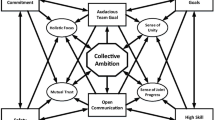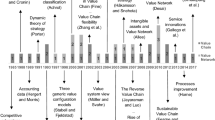Abstract
This paper outlines the results of a project aiming to develop and apply methods for service co-creation with customers, focusing on the early phases of service development. The project is collaboration between a manufacturing firm in the automotive industry, one of their B2B-customers (a transportation firm), as well as a university, all in Sweden. The research team selected and developed methods and work practices for problem analysis, idea generation, development and evaluation of services. Thus doing, methodological influence was taken from the area of engineering design. The proposed approaches were applied in a service development experiment mainly based on workshops. The experiment was followed up by an analysis of the resulting output, an interview series, and an evaluation by peers in focus groups. The goal of this article is to answer the following research questions: (1) What is the industrial applicability of co-creating services using a structured approach, e.g. what are the benefits and challenges? (2) What do the different actors contribute with using this approach, and what possible factors influence the nature and quality of the actors’ contributions? (3) Based on the answers to the questions above, what aspects should be considered to support situated planning and execution of future service co-creation projects? A central conclusion is that a structured approach is industrially applicable, but it is also evident that there is no completely universal recipe for service innovation. Addressing these insights, the paper also contributes with guidelines to support the situation-adapted set-up of future service co-creation projects.






Similar content being viewed by others
References
Almefelt L (2005) Requirements-driven product innovation—methods and tools reflecting industrial needs. Ph.D. Thesis, Chalmers University of Technology, Sweden
Almefelt L, Berglund F, Nilsson P, Malmqvist J (2006) Requirements management in practice: findings from an empirical study in the automotive industry. Res Eng Design 17(3):113–134
Almefelt L, Rexfelt O, Zackrisson D and Hallman T (2009) Methodology for service innovation in a Multi-Disciplinary context. In: Proceedings of ICED’09, pp 5–405
ALMEGA (The Swedish organisation of service companies) (2008) Innovativa tjänsteföretag och forskarsamhället
Alonso-Rasgado T, Thompson G, Dannemark OJ (2004) State of the art in service design & modelling. Vivace Project, Manchester
Amabile TM (1998) How to kill creativity. Harvard Business Review 76(5):76–87
Araujo CS (2001) Acquisition of product development tools in industry: a theoretical contribution. Ph.D. Thesis, Technical University of Denmark, Denmark
Bateson J (1977) Do we need service marketing? Marketing consumer services: new insights, report 75–115. Marketing Science Institute, Boston
Bitran G, Pedrosa L (1998) A structured product development perspective for service operations. European Management Journal 16(2):169–189
Braha D, Reich Y (2003) Topological structures for modelling engineering design processes. Res Eng Design 14(4):185–199
Brown S (2000) The move to solutions providers. Market Manag 9(1):10
Bullinger HJ, Fähnrich KP, Meiren T (2003) Service engineering—methodical development of new service products. International Journal of Production Economics 85:275–287
Chia MC, Chin TC, Chin HH (2002) A review of service quality in corporate and recreational sport/fitness programs. The Sport Journal 5(3):1–9
Clark G, Johnston R, Shulver M (2000) Exploiting the service concept for service design and development. In: Fitzsimmons J, Fitzsimmons M (eds) New service design. Thousand Oaks, CA, Sage
Goldschmidt G, Smolkov M (2006) Variances in the impact of visual stimuli on design problem solving performance. Des Stud 27(5):549–569
Grönroos C (2007) Service management and marketing—customer management in service competition, 3rd edn. Wiley, London
Guba EG, Lincoln YS (1989) Fourth generation evaluation. Sage, Newbury Park
Hatchuel A, Weil B (2003) A new approach of innovative design: an introduction to C-K theory. In: Proceedings of ICED’03. Stockholm, Sweden, pp 109–124
Isaksson O, Larsson TC, Rönnbäck Öhrwall A (2009) Development of product-service systems: challenges and opportunities for the manufacturing firm. J Eng Des 20(4):329–348
Jensen TE, Andreasen MM (2010) Design methods in practice—beyond the “Systematic Approach” of Pahl & Beitz. In: Proceedings design 2010. Dubrovnik, Croatia, pp 21–28
Johne A, Storey C (1998) New service development: a review of the literature and annotated bibliography. Eur J Mark 32(3/4):184–251
Legardeur J, Boujut JF, Tiger H (2010) Lessons Learned from an empirical study of the early phases of an unfulfilled innovation. Res Eng Design (online first, 8 April 2010)
López-Mesa B, Thompson G (2006) On the significance of cognitive style and the selection of appropriate design methods. J Eng Des 17(4):371–386
López-Mesa B, Mulet E, Vidal R, Thompson G (2009) Effects of additional stimuli on idea-finding in design teams. J Eng Design (iFirst, 29 June 2009)
Lovelock C, Gummesson E (2004) Whither services marketing? In search of a new paradigm and fresh perspectives. Journal of Service Marketing 7(1):20–41
Luecke R, Katz R (2003) Managing creativity and innovation. Harvard Business School Press, Boston
Matthing J, Sandén B, Edvardsson B (2004) New service development learning from and with customers. International Journal of Service Industry Management 15(5):479–498
Meier H, Roy R, Seliger G (2008) Industrial product-service systems—IPS2. CIRP Ann Manufact Technol 59(2):607–627
Menor L, Tatikonda M, Sampson S (2002) New service development: areas for exploitation and exploration. J Oper Manag 20(2):135–157
Moritz S (2005) Service design: practical access to an evolving field. Köln International School of Design, Cologne
Norell M (1992) Stödmetoder och samverkan i produktutveckling (Advisory tools and co-operation in product development). Ph.D. Thesis, Royal Institute of Technology, Stockholm, Sweden
Ottosson S (1996) Dynamic product development: findings from participating action research in a fast new product development process. J Eng Des 7(2):151–169
Pahl G, Beitz W (1996) Engineering design, a systematic approach, 2nd English edn. Springer, Berlin
Parasuraman A, Zeithaml VA, Berry LL (1985) A conceptual model of service quality and its implications for future research. Journal of Retailing 49:41–50
Pugh S (1991) Total design: integrated methods for successful product engineering. Addison-Wesley, New York
Reich Y, Konda SL, Monarch IA, Levy SN, Subrahmanian E (1996) Varieties and issues of participation and design. Des Stud 17:165–180
Reich Y, Ullmann G, Van der Loos M, Leifer L (2009) Coaching product development teams: a conceptual foundation for empirical studies. Res Eng Design 19:205–222
Rexfelt O (2008) User-centred design and technology-mediated services-identifying and addressing challenges by analysing activities. Ph.D. Thesis, Chalmers University of Technology, Sweden
Sarkar P, Chakrabarti A (2008) The effect of representation of triggers on design outcomes. Artif Intell Eng Design Anal Manufact 22(2):101–117
Schumpeter J (1934) The theory of economic development. Harvard University Press, Cambridge
Segers NM, de Vries B, Achten HH (2005) Do word graphs stimulate design? Des Stud 26(6):625–647
Spat D, Fähnrich KP (2008) Advances in services innovations. Springer, New York
Suh NP (1990) The principles of design. Oxford University Press, Oxford
Svensson L, Brulin G, Ellström PE, Widegren Ö (2002) Interaktiv forskning—för utveckling av teori och praktik (Interactive research—for development of theory and practice). Arbetslivsinstitutet, Stockholm in Swedish
Tjalve E (1979) A short course on industrial design. Newnes-Butterworths, London
Vargo SL, Lusch RF (2004) Evolving to a new dominant logic for marketing. Journal of Marketing 68(1):1–17
Veeke H, Lodewijks G, Ottjes J (2006) Conceptual design of industrial systems: an approach to support collaboration. Res Eng Design 17(2):85–101
Vidal R, Mulet E, Gómez-Senent E (2004) Effectiveness of the means of expression in creative problem-solving in design groups. J Eng Des 3(3):285–298
Yin R (1994) Case study research: design and methods. Sage Publishing, Beverly Hills
Zwicky F (1971) Entdecken, Erfinden, Forschen im Morphologischen Weltbild. Droemer-Knaur, München
Acknowledgments
We would like to express our thanks to all team members for making the workshops and interviews reality. In addition, the financial support from Vinnova, the Swedish Governmental Agency for Innovation Systems, is gratefully acknowledged.
Author information
Authors and Affiliations
Corresponding author
Rights and permissions
About this article
Cite this article
Rexfelt, O., Almefelt, L., Zackrisson, D. et al. A proposal for a structured approach for cross-company teamwork: a case study of involving the customer in service innovation. Res Eng Design 22, 153–171 (2011). https://doi.org/10.1007/s00163-011-0104-y
Received:
Accepted:
Published:
Issue Date:
DOI: https://doi.org/10.1007/s00163-011-0104-y




